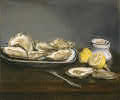Tour: Manet and His Influence
| Overview | Start Tour | ||
 |
 |
 |
| 1 | 2 | 3 |
 |
 |
 |
| 4 | 5 | 6 |
| » | next | |||
| « | back to French Painting of the 19th century | |||
Overview
It is hard to image a time when Paris was without broad, tree-lined streets or when the life of the city did not interest French artists. Yet this was the case in 1850 when Edouard Manet began to study painting. Young artists could expect to succeed only through the official Academy exhibitions known as Salons, whose conservative juries favored biblical and mythological themes and a polished technique. Within twenty-five years, however, both Paris and painting had a new look. Urban renovations had opened the wide avenues and parks we know today, and painting was transformed when artists abandoned the transparent glazes and blended brushtrokes of the past and turned their attention to life around them. Contemporary urban subjects and a bold style, which offered paint on the canvas as something to be admired in itself, gave their art a strong new sense of the present.
(continue)
Captions


